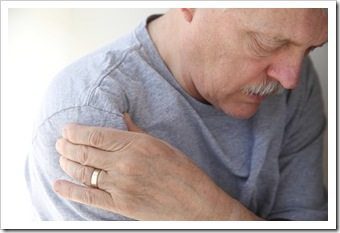
The rotator cuff is the most important group of muscles giving the shoulder support and stability. This structural support allows the shoulder joint to move and turn through a wide range of motions and allows us to perform an amazing variety of tasks with our arms. Due to this mobility, rotator cuff injuries are very common. This mobility is at the expense of shoulder stability. A small injury can happen in one of the tendons/muscles but this can very easily progress to other muscle areas becoming irritated due to compensation patterns.
What starts off as a simple problem can often lead to a more complex issue where the original injury site is not so obvious and can make many routine activities difficult and painful.
The Rotator Cuff
The rotator cuff muscle group lies all around the shoulder blade…in front, either side and on top. These muscle fibers then all lead up to the arm bone where they become tendons and attach onto the top part of the arm.
Individually the muscles are the supraspinatus, which is responsible for the movement of the arm to move away from the body at the shoulder; the infraspinatus and teres minor, which externally rotate the arm and the subscapularis, which internally rotates the bone in the upper arm. Their function is to stabilize the shoulder joint on moving but of course to also move the arm bone itself.
Injuries to the Rotator Cuff
Rotator cuff syndrome is a broad term used to describe injuries and damage to the rotator cuff. There is a spectrum of injuries that can occur. Common injuries include partial tears in the muscles and tendons, which can result from acute injury or wear and tear over the long term. Many times repetitive motion that puts stress on the rotator cuff is the chief culprit for the injury.
Very common symptoms of a rotator cuff injury may include the inability to lift the arm at the shoulder out to the side, pain on putting a coat on or pain when sleeping on that side at night. Some people also may experience pain radiating down the arm towards the elbow or even down into their hands.
Like most musculoskeletal conditions, the most common mechanisms of a rotator cuff injuries are separated into ‘repetitive micro-trauma’ and ‘traumatic injuries‘. There are always exceptions to the rule, but the following is generally true for both types of injuries.
- Repetitive Micro-trauma: In repetitive use injuries to the rotator cuff, repeated activities cause damage to the rotator cuff tendons. Over time, the tendons wear faster that the body can repair them and a micro-tear can develop within the tendons. Patients with repetitive use injuries to the rotator cuff often have complaints of shoulder pain prior to developing a complete rotator cuff tear.
- Traumatic Injuries: Traumatic injuries to the rotator cuff are seen after events such as throwing, golf and falling onto an outstretched arm. The traumatic event can cause a rotator cuff tear by injuring the rotator cuff tendons. This mechanism is much less common than repetitive use injuries. If you have had a rotator cuff tendonitis before, you are more likely to have a tear of the tendon due to scar tissue formation, which renders the tendon inherently weaker than normal.
A rotator cuff tear is seen both in the young and old, but a complete tear is much more common if you are older. This is the case due to the fact that as you age, the muscle and tendon tissue of the rotator cuff loses some elasticity. With the loss of elasticity it leads the way to the inherent poor blood supply to the mid part of the tendon; therefore, healing is slow and degenerative changes are often found.
In younger people, there is usually either a traumatic injury such as a fall, or the person is putting the tendon under significant load, as seen in athletes.
The Best Treatment for a Rotator Cuff Injuries
In order to effectively treat rotator cuff syndrome, it is important to address the underlying causes of it.
Because the rotator cuff is comprised of four different muscles, rotator cuff syndrome can describe one of the several different problems. Pain may be the result of overuse or injury of one or more of the muscles in the rotator cuff; therefore, developing a treatment plan individualized to the particular cause of the pain is crucial. A medical specialist, such as a chiropractor, will result in the highest quality of care as the cause will be more individually identified, and more easily resolved.
Rehabilitative care and rest are the recommended course of action for effectively reducing the incidence of pain and restoring full function to the arms and shoulders. As with many other repetitive movement injuries, massage therapy in conjunction with chiropractic care can provide not only pain relief but the highest restoration of range of movement.
Massage therapy and chiropractic care work hand-in-hand expertly in this capacity. The massage therapy softens the inflamed tissues allowing the patient to regain improved circulation and some aspect of comfortable motion. Chiropractic care will address the underlying condition. This is completed by safe gentle chiropractic adjustments of the shoulder and associated areas which will help to re-train the soft tissue to return to its appropriate origin, furthering the restoration of full range of motion and eliminating the inflammation.
Soft tissue treatments such as ART and Graston work are often used in conjunction to reduce the incidence and symptoms of inflammation, sending fibrous adhesions that inhibit functional movement back into circulation. Kinesiotape can be advantageous as well by helping correct and maintain proper shoulder positioning throughout the day by stimulating proprioception, increasing your body’s positional awareness.
The most beneficial treatment process delivers the best results when a Chiropractic physician also provides detailed rehabilitative programs targeted to preserve and build muscle strength during the healing process.
On Your Team!
Shoulder injuries do not need to be athletically related and can happen at any age.
So if you are suffering from a rotator cuff injury, call us today to let us help you get back to activities you love most in life.
For Your Health,
Dr. Che Connelly
